Partnering with Patients in Their Own Care: Sharing Decision and Planning Care
VerifiedAdded on 2023/06/03
|8
|1964
|247
AI Summary
The report analyses the importance of informed consent in the domain of person-centred care. The evaluation of resources and the process employed to implement informed consent highlighted that training along with written legal approval are best procedure to complete action 2.4.
Contribute Materials
Your contribution can guide someone’s learning journey. Share your
documents today.

Running head: NURSING
Developing Professional Nursing Practice
Name of the Student
Name of the University
Author Note
Developing Professional Nursing Practice
Name of the Student
Name of the University
Author Note
Secure Best Marks with AI Grader
Need help grading? Try our AI Grader for instant feedback on your assignments.
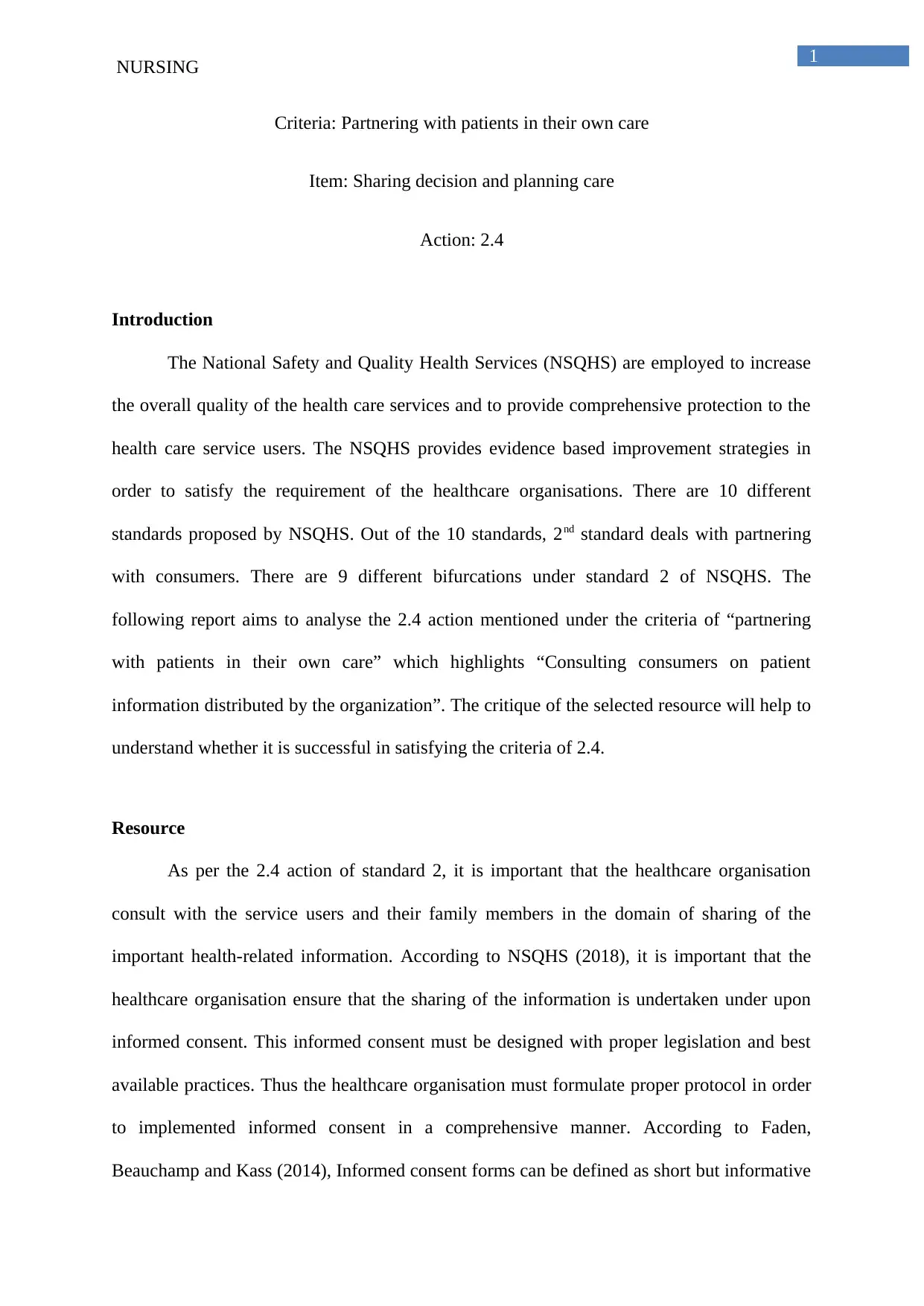
1
NURSING
Criteria: Partnering with patients in their own care
Item: Sharing decision and planning care
Action: 2.4
Introduction
The National Safety and Quality Health Services (NSQHS) are employed to increase
the overall quality of the health care services and to provide comprehensive protection to the
health care service users. The NSQHS provides evidence based improvement strategies in
order to satisfy the requirement of the healthcare organisations. There are 10 different
standards proposed by NSQHS. Out of the 10 standards, 2nd standard deals with partnering
with consumers. There are 9 different bifurcations under standard 2 of NSQHS. The
following report aims to analyse the 2.4 action mentioned under the criteria of “partnering
with patients in their own care” which highlights “Consulting consumers on patient
information distributed by the organization”. The critique of the selected resource will help to
understand whether it is successful in satisfying the criteria of 2.4.
Resource
As per the 2.4 action of standard 2, it is important that the healthcare organisation
consult with the service users and their family members in the domain of sharing of the
important health-related information. According to NSQHS (2018), it is important that the
healthcare organisation ensure that the sharing of the information is undertaken under upon
informed consent. This informed consent must be designed with proper legislation and best
available practices. Thus the healthcare organisation must formulate proper protocol in order
to implemented informed consent in a comprehensive manner. According to Faden,
Beauchamp and Kass (2014), Informed consent forms can be defined as short but informative
NURSING
Criteria: Partnering with patients in their own care
Item: Sharing decision and planning care
Action: 2.4
Introduction
The National Safety and Quality Health Services (NSQHS) are employed to increase
the overall quality of the health care services and to provide comprehensive protection to the
health care service users. The NSQHS provides evidence based improvement strategies in
order to satisfy the requirement of the healthcare organisations. There are 10 different
standards proposed by NSQHS. Out of the 10 standards, 2nd standard deals with partnering
with consumers. There are 9 different bifurcations under standard 2 of NSQHS. The
following report aims to analyse the 2.4 action mentioned under the criteria of “partnering
with patients in their own care” which highlights “Consulting consumers on patient
information distributed by the organization”. The critique of the selected resource will help to
understand whether it is successful in satisfying the criteria of 2.4.
Resource
As per the 2.4 action of standard 2, it is important that the healthcare organisation
consult with the service users and their family members in the domain of sharing of the
important health-related information. According to NSQHS (2018), it is important that the
healthcare organisation ensure that the sharing of the information is undertaken under upon
informed consent. This informed consent must be designed with proper legislation and best
available practices. Thus the healthcare organisation must formulate proper protocol in order
to implemented informed consent in a comprehensive manner. According to Faden,
Beauchamp and Kass (2014), Informed consent forms can be defined as short but informative
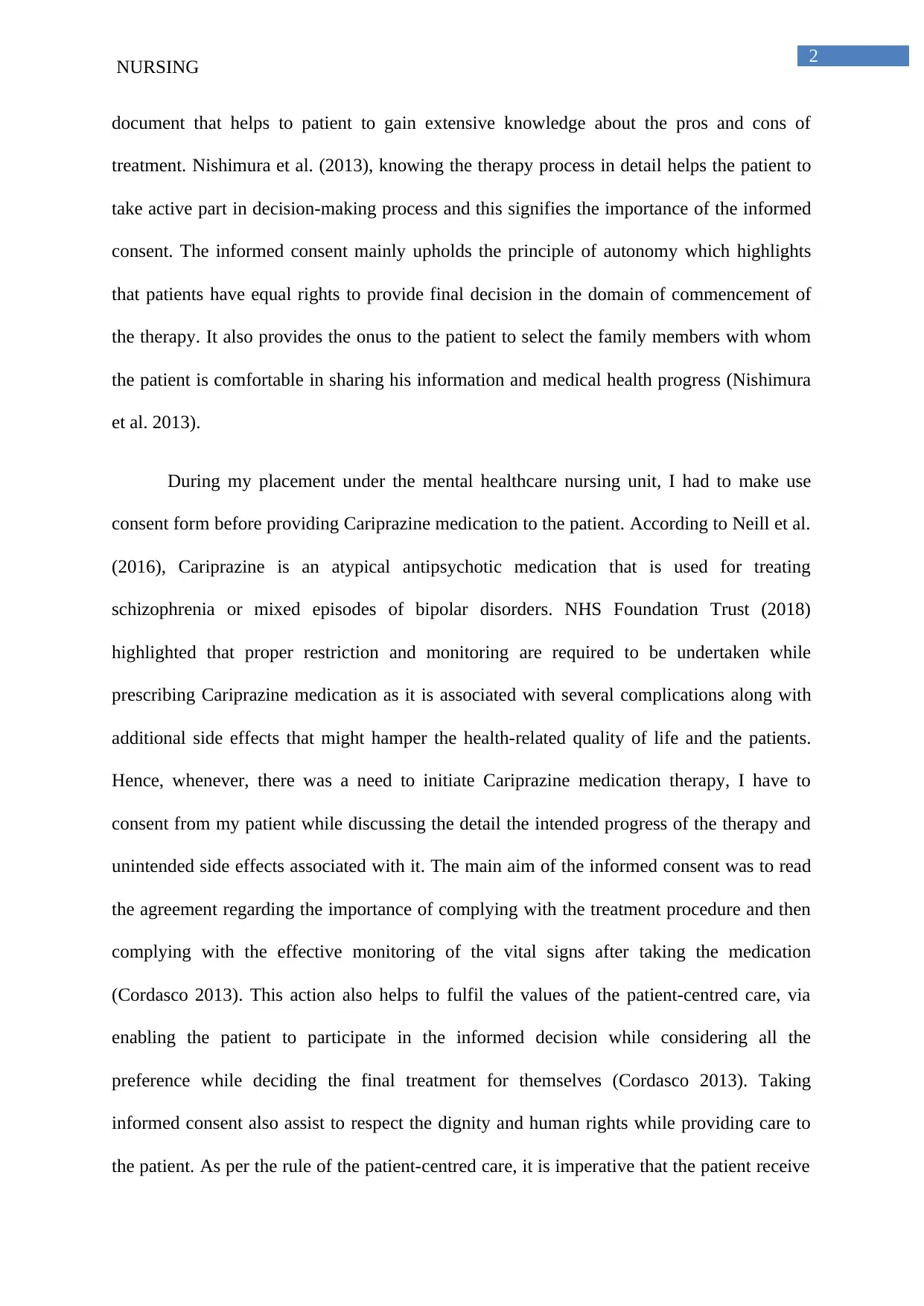
2
NURSING
document that helps to patient to gain extensive knowledge about the pros and cons of
treatment. Nishimura et al. (2013), knowing the therapy process in detail helps the patient to
take active part in decision-making process and this signifies the importance of the informed
consent. The informed consent mainly upholds the principle of autonomy which highlights
that patients have equal rights to provide final decision in the domain of commencement of
the therapy. It also provides the onus to the patient to select the family members with whom
the patient is comfortable in sharing his information and medical health progress (Nishimura
et al. 2013).
During my placement under the mental healthcare nursing unit, I had to make use
consent form before providing Cariprazine medication to the patient. According to Neill et al.
(2016), Cariprazine is an atypical antipsychotic medication that is used for treating
schizophrenia or mixed episodes of bipolar disorders. NHS Foundation Trust (2018)
highlighted that proper restriction and monitoring are required to be undertaken while
prescribing Cariprazine medication as it is associated with several complications along with
additional side effects that might hamper the health-related quality of life and the patients.
Hence, whenever, there was a need to initiate Cariprazine medication therapy, I have to
consent from my patient while discussing the detail the intended progress of the therapy and
unintended side effects associated with it. The main aim of the informed consent was to read
the agreement regarding the importance of complying with the treatment procedure and then
complying with the effective monitoring of the vital signs after taking the medication
(Cordasco 2013). This action also helps to fulfil the values of the patient-centred care, via
enabling the patient to participate in the informed decision while considering all the
preference while deciding the final treatment for themselves (Cordasco 2013). Taking
informed consent also assist to respect the dignity and human rights while providing care to
the patient. As per the rule of the patient-centred care, it is imperative that the patient receive
NURSING
document that helps to patient to gain extensive knowledge about the pros and cons of
treatment. Nishimura et al. (2013), knowing the therapy process in detail helps the patient to
take active part in decision-making process and this signifies the importance of the informed
consent. The informed consent mainly upholds the principle of autonomy which highlights
that patients have equal rights to provide final decision in the domain of commencement of
the therapy. It also provides the onus to the patient to select the family members with whom
the patient is comfortable in sharing his information and medical health progress (Nishimura
et al. 2013).
During my placement under the mental healthcare nursing unit, I had to make use
consent form before providing Cariprazine medication to the patient. According to Neill et al.
(2016), Cariprazine is an atypical antipsychotic medication that is used for treating
schizophrenia or mixed episodes of bipolar disorders. NHS Foundation Trust (2018)
highlighted that proper restriction and monitoring are required to be undertaken while
prescribing Cariprazine medication as it is associated with several complications along with
additional side effects that might hamper the health-related quality of life and the patients.
Hence, whenever, there was a need to initiate Cariprazine medication therapy, I have to
consent from my patient while discussing the detail the intended progress of the therapy and
unintended side effects associated with it. The main aim of the informed consent was to read
the agreement regarding the importance of complying with the treatment procedure and then
complying with the effective monitoring of the vital signs after taking the medication
(Cordasco 2013). This action also helps to fulfil the values of the patient-centred care, via
enabling the patient to participate in the informed decision while considering all the
preference while deciding the final treatment for themselves (Cordasco 2013). Taking
informed consent also assist to respect the dignity and human rights while providing care to
the patient. As per the rule of the patient-centred care, it is imperative that the patient receive
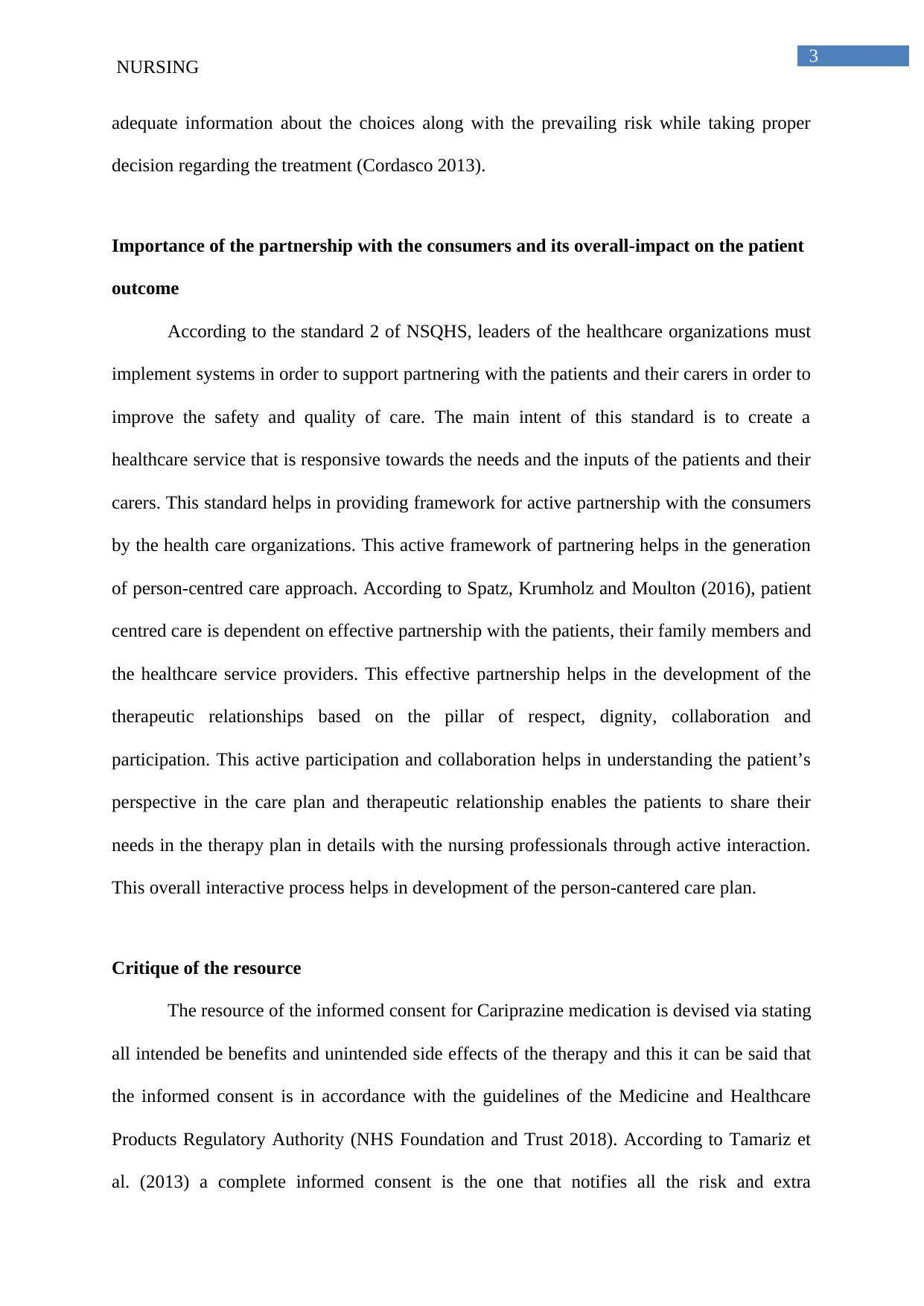
3
NURSING
adequate information about the choices along with the prevailing risk while taking proper
decision regarding the treatment (Cordasco 2013).
Importance of the partnership with the consumers and its overall-impact on the patient
outcome
According to the standard 2 of NSQHS, leaders of the healthcare organizations must
implement systems in order to support partnering with the patients and their carers in order to
improve the safety and quality of care. The main intent of this standard is to create a
healthcare service that is responsive towards the needs and the inputs of the patients and their
carers. This standard helps in providing framework for active partnership with the consumers
by the health care organizations. This active framework of partnering helps in the generation
of person-centred care approach. According to Spatz, Krumholz and Moulton (2016), patient
centred care is dependent on effective partnership with the patients, their family members and
the healthcare service providers. This effective partnership helps in the development of the
therapeutic relationships based on the pillar of respect, dignity, collaboration and
participation. This active participation and collaboration helps in understanding the patient’s
perspective in the care plan and therapeutic relationship enables the patients to share their
needs in the therapy plan in details with the nursing professionals through active interaction.
This overall interactive process helps in development of the person-cantered care plan.
Critique of the resource
The resource of the informed consent for Cariprazine medication is devised via stating
all intended be benefits and unintended side effects of the therapy and this it can be said that
the informed consent is in accordance with the guidelines of the Medicine and Healthcare
Products Regulatory Authority (NHS Foundation and Trust 2018). According to Tamariz et
al. (2013) a complete informed consent is the one that notifies all the risk and extra
NURSING
adequate information about the choices along with the prevailing risk while taking proper
decision regarding the treatment (Cordasco 2013).
Importance of the partnership with the consumers and its overall-impact on the patient
outcome
According to the standard 2 of NSQHS, leaders of the healthcare organizations must
implement systems in order to support partnering with the patients and their carers in order to
improve the safety and quality of care. The main intent of this standard is to create a
healthcare service that is responsive towards the needs and the inputs of the patients and their
carers. This standard helps in providing framework for active partnership with the consumers
by the health care organizations. This active framework of partnering helps in the generation
of person-centred care approach. According to Spatz, Krumholz and Moulton (2016), patient
centred care is dependent on effective partnership with the patients, their family members and
the healthcare service providers. This effective partnership helps in the development of the
therapeutic relationships based on the pillar of respect, dignity, collaboration and
participation. This active participation and collaboration helps in understanding the patient’s
perspective in the care plan and therapeutic relationship enables the patients to share their
needs in the therapy plan in details with the nursing professionals through active interaction.
This overall interactive process helps in development of the person-cantered care plan.
Critique of the resource
The resource of the informed consent for Cariprazine medication is devised via stating
all intended be benefits and unintended side effects of the therapy and this it can be said that
the informed consent is in accordance with the guidelines of the Medicine and Healthcare
Products Regulatory Authority (NHS Foundation and Trust 2018). According to Tamariz et
al. (2013) a complete informed consent is the one that notifies all the risk and extra
Paraphrase This Document
Need a fresh take? Get an instant paraphrase of this document with our AI Paraphraser
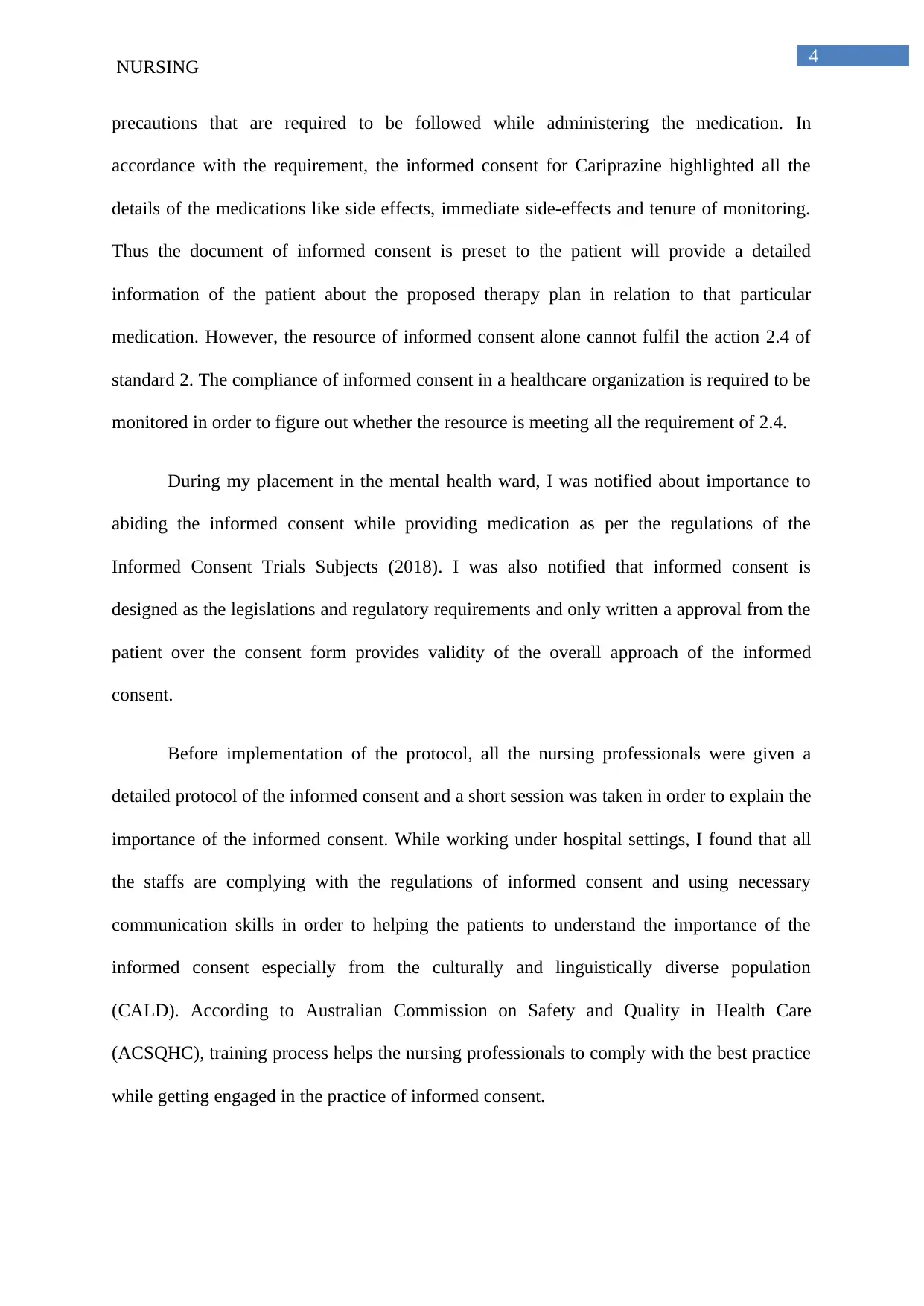
4
NURSING
precautions that are required to be followed while administering the medication. In
accordance with the requirement, the informed consent for Cariprazine highlighted all the
details of the medications like side effects, immediate side-effects and tenure of monitoring.
Thus the document of informed consent is preset to the patient will provide a detailed
information of the patient about the proposed therapy plan in relation to that particular
medication. However, the resource of informed consent alone cannot fulfil the action 2.4 of
standard 2. The compliance of informed consent in a healthcare organization is required to be
monitored in order to figure out whether the resource is meeting all the requirement of 2.4.
During my placement in the mental health ward, I was notified about importance to
abiding the informed consent while providing medication as per the regulations of the
Informed Consent Trials Subjects (2018). I was also notified that informed consent is
designed as the legislations and regulatory requirements and only written a approval from the
patient over the consent form provides validity of the overall approach of the informed
consent.
Before implementation of the protocol, all the nursing professionals were given a
detailed protocol of the informed consent and a short session was taken in order to explain the
importance of the informed consent. While working under hospital settings, I found that all
the staffs are complying with the regulations of informed consent and using necessary
communication skills in order to helping the patients to understand the importance of the
informed consent especially from the culturally and linguistically diverse population
(CALD). According to Australian Commission on Safety and Quality in Health Care
(ACSQHC), training process helps the nursing professionals to comply with the best practice
while getting engaged in the practice of informed consent.
NURSING
precautions that are required to be followed while administering the medication. In
accordance with the requirement, the informed consent for Cariprazine highlighted all the
details of the medications like side effects, immediate side-effects and tenure of monitoring.
Thus the document of informed consent is preset to the patient will provide a detailed
information of the patient about the proposed therapy plan in relation to that particular
medication. However, the resource of informed consent alone cannot fulfil the action 2.4 of
standard 2. The compliance of informed consent in a healthcare organization is required to be
monitored in order to figure out whether the resource is meeting all the requirement of 2.4.
During my placement in the mental health ward, I was notified about importance to
abiding the informed consent while providing medication as per the regulations of the
Informed Consent Trials Subjects (2018). I was also notified that informed consent is
designed as the legislations and regulatory requirements and only written a approval from the
patient over the consent form provides validity of the overall approach of the informed
consent.
Before implementation of the protocol, all the nursing professionals were given a
detailed protocol of the informed consent and a short session was taken in order to explain the
importance of the informed consent. While working under hospital settings, I found that all
the staffs are complying with the regulations of informed consent and using necessary
communication skills in order to helping the patients to understand the importance of the
informed consent especially from the culturally and linguistically diverse population
(CALD). According to Australian Commission on Safety and Quality in Health Care
(ACSQHC), training process helps the nursing professionals to comply with the best practice
while getting engaged in the practice of informed consent.
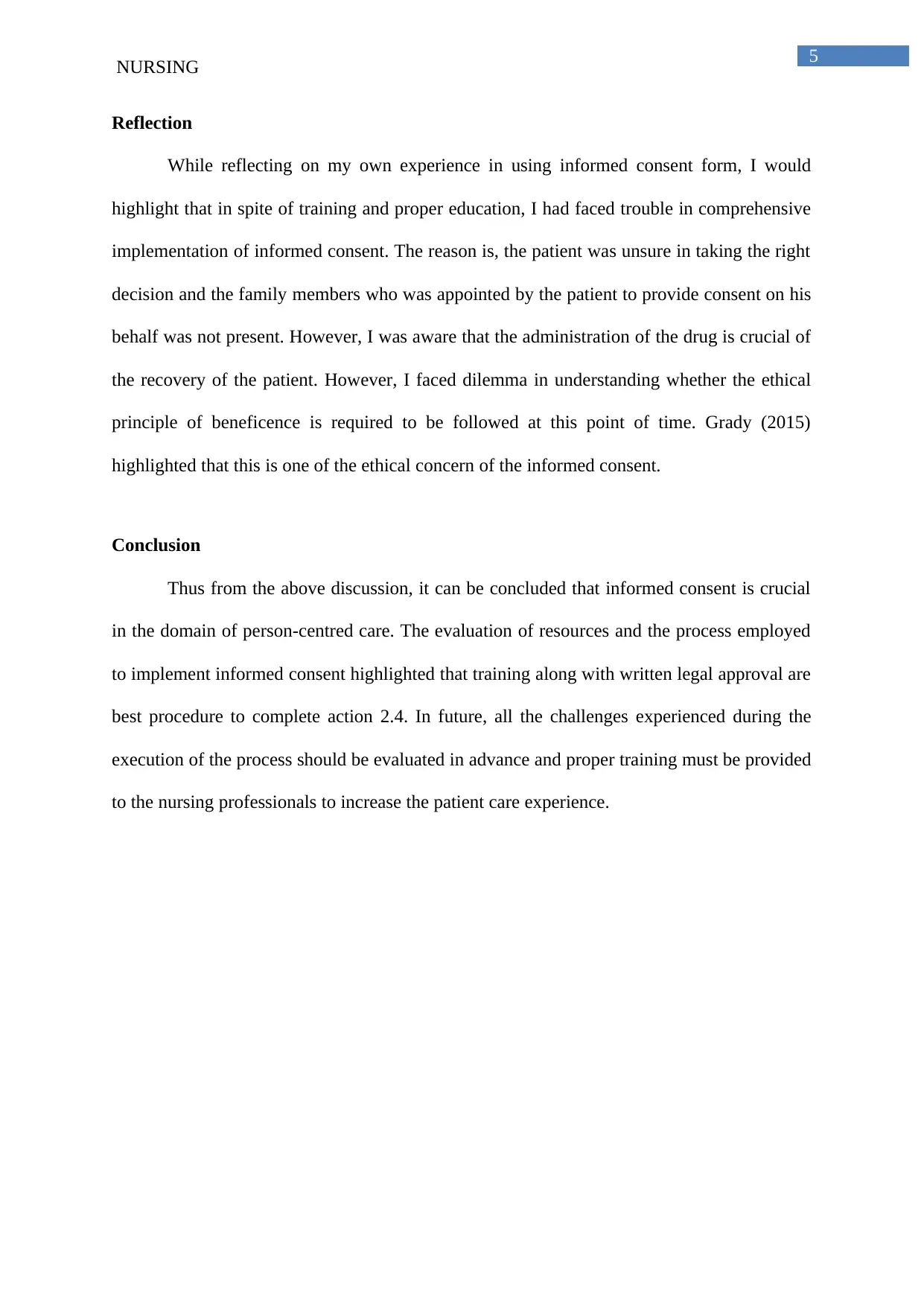
5
NURSING
Reflection
While reflecting on my own experience in using informed consent form, I would
highlight that in spite of training and proper education, I had faced trouble in comprehensive
implementation of informed consent. The reason is, the patient was unsure in taking the right
decision and the family members who was appointed by the patient to provide consent on his
behalf was not present. However, I was aware that the administration of the drug is crucial of
the recovery of the patient. However, I faced dilemma in understanding whether the ethical
principle of beneficence is required to be followed at this point of time. Grady (2015)
highlighted that this is one of the ethical concern of the informed consent.
Conclusion
Thus from the above discussion, it can be concluded that informed consent is crucial
in the domain of person-centred care. The evaluation of resources and the process employed
to implement informed consent highlighted that training along with written legal approval are
best procedure to complete action 2.4. In future, all the challenges experienced during the
execution of the process should be evaluated in advance and proper training must be provided
to the nursing professionals to increase the patient care experience.
NURSING
Reflection
While reflecting on my own experience in using informed consent form, I would
highlight that in spite of training and proper education, I had faced trouble in comprehensive
implementation of informed consent. The reason is, the patient was unsure in taking the right
decision and the family members who was appointed by the patient to provide consent on his
behalf was not present. However, I was aware that the administration of the drug is crucial of
the recovery of the patient. However, I faced dilemma in understanding whether the ethical
principle of beneficence is required to be followed at this point of time. Grady (2015)
highlighted that this is one of the ethical concern of the informed consent.
Conclusion
Thus from the above discussion, it can be concluded that informed consent is crucial
in the domain of person-centred care. The evaluation of resources and the process employed
to implement informed consent highlighted that training along with written legal approval are
best procedure to complete action 2.4. In future, all the challenges experienced during the
execution of the process should be evaluated in advance and proper training must be provided
to the nursing professionals to increase the patient care experience.

6
NURSING
References
Australian Commission on Safety and Quality in Health Care (ACSQHC) 2017, National
Safety and Quality Health Services Standards, ACSQHC, Sydney, NSW, viewed 7th October
2018, < https://www.safetyandquality.gov.au/wp-content/uploads/2017/12/National-Safety-
and-Quality-Health-Service-Standards-second-edition.pdf>.
Cordasco, K.M., 2013. Obtaining informed consent from patients: Brief update
review. Making health care safer II: An updated critical analysis of the evidence for patient
safety practices, (211).
Faden, R.R., Beauchamp, T.L. and Kass, N.E., 2014. Informed consent, comparative
effectiveness, and learning health care. N Engl J Med, 370(8), pp.766-768.
Grady, C., 2015. Enduring and emerging challenges of informed consent. New England
Journal of Medicine, 372(9), pp.855-862.
ICH 2018, Informed Consent of Trial Subjects, Viewed on 7th October 2018,
https://ichgcp.net/48-informed-consent-of-trial-subjects
National Safety and Quality Health Service Standards 2018, Sharing decisions and planning
care. [online] Viewed 6th October 2018, Available at:
http://www.nationalstandards.safetyandquality.gov.au/2.-partnering-consumers/partnering-
patients-their-own-care/sharing-decisions-and-planning-care
Neill, J.C., Grayson, B., Kiss, B., Gyertyán, I., Ferguson, P. and Adham, N., 2016. Effects of
cariprazine, a novel antipsychotic, on cognitive deficit and negative symptoms in a rodent
model of schizophrenia symptomatology. European Neuropsychopharmacology, 26(1), pp.3-
14.
NURSING
References
Australian Commission on Safety and Quality in Health Care (ACSQHC) 2017, National
Safety and Quality Health Services Standards, ACSQHC, Sydney, NSW, viewed 7th October
2018, < https://www.safetyandquality.gov.au/wp-content/uploads/2017/12/National-Safety-
and-Quality-Health-Service-Standards-second-edition.pdf>.
Cordasco, K.M., 2013. Obtaining informed consent from patients: Brief update
review. Making health care safer II: An updated critical analysis of the evidence for patient
safety practices, (211).
Faden, R.R., Beauchamp, T.L. and Kass, N.E., 2014. Informed consent, comparative
effectiveness, and learning health care. N Engl J Med, 370(8), pp.766-768.
Grady, C., 2015. Enduring and emerging challenges of informed consent. New England
Journal of Medicine, 372(9), pp.855-862.
ICH 2018, Informed Consent of Trial Subjects, Viewed on 7th October 2018,
https://ichgcp.net/48-informed-consent-of-trial-subjects
National Safety and Quality Health Service Standards 2018, Sharing decisions and planning
care. [online] Viewed 6th October 2018, Available at:
http://www.nationalstandards.safetyandquality.gov.au/2.-partnering-consumers/partnering-
patients-their-own-care/sharing-decisions-and-planning-care
Neill, J.C., Grayson, B., Kiss, B., Gyertyán, I., Ferguson, P. and Adham, N., 2016. Effects of
cariprazine, a novel antipsychotic, on cognitive deficit and negative symptoms in a rodent
model of schizophrenia symptomatology. European Neuropsychopharmacology, 26(1), pp.3-
14.
Secure Best Marks with AI Grader
Need help grading? Try our AI Grader for instant feedback on your assignments.

7
NURSING
NHS Foundation Trust 2018, Procedure and Guidance for the use of Clozapine, viewed 7th
October 2018< http://www.sussexpartnership.nhs.uk/sites/default/files/documents/
clozapine_full_guide_trust_v22_-_1011_321_2.pdf
Nishimura, A., Carey, J., Erwin, P.J., Tilburt, J.C., Murad, M.H. and McCormick, J.B., 2013.
Improving understanding in the research informed consent process: a systematic review of 54
interventions tested in randomized control trials. BMC medical ethics, 14(1), p.28.
Spatz, E.S., Krumholz, H.M. and Moulton, B.W., 2016. The new era of informed consent:
getting to a reasonable-patient standard through shared decision making. Jama, 315(19),
pp.2063-2064.
Tamariz, L., Palacio, A., Robert, M. and Marcus, E.N., 2013. Improving the informed
consent process for research subjects with low literacy: a systematic review. Journal of
general internal medicine, 28(1), pp.121-126.
NURSING
NHS Foundation Trust 2018, Procedure and Guidance for the use of Clozapine, viewed 7th
October 2018< http://www.sussexpartnership.nhs.uk/sites/default/files/documents/
clozapine_full_guide_trust_v22_-_1011_321_2.pdf
Nishimura, A., Carey, J., Erwin, P.J., Tilburt, J.C., Murad, M.H. and McCormick, J.B., 2013.
Improving understanding in the research informed consent process: a systematic review of 54
interventions tested in randomized control trials. BMC medical ethics, 14(1), p.28.
Spatz, E.S., Krumholz, H.M. and Moulton, B.W., 2016. The new era of informed consent:
getting to a reasonable-patient standard through shared decision making. Jama, 315(19),
pp.2063-2064.
Tamariz, L., Palacio, A., Robert, M. and Marcus, E.N., 2013. Improving the informed
consent process for research subjects with low literacy: a systematic review. Journal of
general internal medicine, 28(1), pp.121-126.
1 out of 8
Related Documents
Your All-in-One AI-Powered Toolkit for Academic Success.
+13062052269
info@desklib.com
Available 24*7 on WhatsApp / Email
![[object Object]](/_next/static/media/star-bottom.7253800d.svg)
Unlock your academic potential
© 2024 | Zucol Services PVT LTD | All rights reserved.



